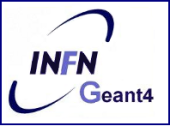Speaker
Dr
Igor Pshenichnov
(Frankfurt Institite for Advanced Studies (FIAS) and Institute for Nuclear Research (INR), Moscow)
Description
We study the validity of nucleus-nucleus collision models of Geant4 describing fragmentation of light and medium-weight nuclei (from $^{3}$He to $^{58}$Ni) in tissue-like media. Depth-dose distributions and yields of secondary fragments produced by nuclear beams were calculated and compared against experimental data. The Light-Ion Binary Cascade model and the Wilson abrasion model were used to simulate the initial stage of nucleus-nucleus collisions. The both models were successful in simulating the transport of light nuclei, e.g. $^{12}$C, while the cascade model overpredicts the dose from heavy energetic nuclei, possibly due to underpredicting the attenuation of the initial beam due to fragmentation.
The calculations were performed with and without the Fermi break-up model and the Statistical Multifragmentation model for multifragment decays of excited light and medium-weight residual nuclei at the final stage of collisions in addition to evaporation model. This allowed us to estimate the role of multifragment decays on the depth-dose, depth-yield and charge distributions of secondary fragments produced in extended media. While the energy deposition is not very sensitive to decay mechanisms of excited nuclei, the fragment yields can not be properly described without accounting for multifragment decays.
The validity of the Statistical Multifragmentation model of Geant4 has been confirmed in a set of stand-alone tests, following several fixes introduced to G4StatMF. These corrections improved the stability of the model and consistency of simulation results with the FORTRAN implementation of the model. Comparisons to experimental data on multifragmentation of hot nuclei in central collisions of nuclei at low energies are also presented.
| Are you a Memeber of the Geant4 Collaboration (yes/no) | no |
|---|
Primary author
Dr
Igor Pshenichnov
(Frankfurt Institite for Advanced Studies (FIAS) and Institute for Nuclear Research (INR), Moscow)
Co-authors
Dr
Alexander Botvina
(Frankfurt Institite for Advanced Studies (FIAS) and Institute for Nuclear Research (INR), Moscow)
Prof.
Igor Mishustin
(Frankfurt Institite for Advanced Studies (FIAS) and Kurchatov Institute, Moscow)
Prof.
Walter Greiner
(Frankfurt Institite for Advanced Studies (FIAS))




